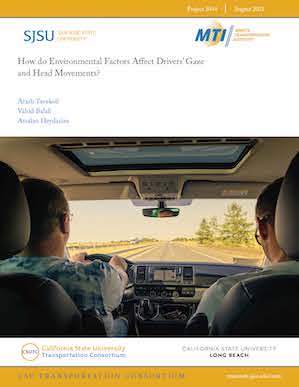- 408-924-7560
- mineta-institute@sjsu.edu
- Donate
How do Environmental Factors Affect Drivers’ Gaze and Head Movements?
Studies have shown that environmental factors affect driving behaviors. For instance, weather conditions and the presence of a passenger have been shown to significantly affect the speed of the driver. As one of the important measures of driving behavior is the gaze and head movements of the driver, such metrics can be potentially used towards understanding the effects of environmental factors on the driver’s behavior in real-time. In this study, using a naturalistic study platform, videos have been collected from six participants for more than four weeks of a fully naturalistic driving scenario. The videos of both the participants’ faces and roads have been cleaned and manually categorized depending on weather, road type, and passenger conditions. Facial videos have been analyzed using OpenFace to retrieve the gaze direction and head movements of the driver. Results, overall, suggest that the gaze direction and head movements of the driver are affected by a combination of environmental factors and individual differences. Specifically, results depict the distracting effect of the passenger on some individuals. In addition, it shows that highways and city streets are the cause for maximum distraction on the driver’s gaze.
ARASH TAVAKOLI
Arash Tavakoli is a PhD candidate, Engineering Systems and Environment (ESE) at the LinkLab of the University of Virginia. He has earned his BSc.and MSc in Civil Engineering from the Sharif University of Technology and Virginia Tech respectively. Arash’s research interest lies on the intersection of psychology, transportation engineering, and computer science. Specifically, Arash implements psychological theories and experimental design together with affective computing and computer vision techniques to enhance human-autonomous vehicle interaction.
VAHID BALALI
PI Vahid Balali, PhD, is an Assistant Professor in the Department of Civil Engineering and Construction Engineering Management at California State University Long Beach. Dr. Balali's research focuses on visual data sensing and analytics, virtual design and construction for civil infrastructure and interoperable system integration, and smart cities in transportation for sustainable decision-making. He also has experience as a visual data analyst and developed a video-based construction resource tracking and action recognition for activity analysis of operators at Caterpillar. He has the knowledge, technical skills, and experience that are crucial to the successful completion of the proposed work. Dr. Vahid Balali has been named a recipient of the 2020 Early Academic Career Excellence Award by the California State University Long Beach. He was also selected as one of the Top 40 under 40 by the Consulting-Specifying-Engineer for the year 2017 and top young professional in California by the Engineering News Record (ENR) for the year 2016. He has received the 2014 second best poster award from the Construction Research Congress, and 2013 CMAA national capital chapter scholarship award. He is currently an associate member of ASCE and CMAA, committee member of the ASCE Data Sensing and Analysis and ASCE Visual Information Modeling and Simulation committees, and friend member of relevant TRB committees. He is also serving as a reviewer of several top-notch Journals. He is actively collaborating with industrial partners and is involved in professional and outreach activities.
ARSALAN HEYDARIAN
Dr. Arsalan Heydarian is an Assistant Professor in the Department of Engineering Systems and Environment at the University of Virginia and he's part of the UVA Cyber-physical systems lab, the LINK LAB. His research broadly focuses on user-centered design, construction, and operation of intelligent infrastructure with the objective of enhancing their sustainability, adaptability, and resilience. Dr. Heydarian received his PhD in Civil Engineering from the University of Southern California (USC), MSc in System Engineering from USC, and BSc and MSc in Civil Engineering from Virginia Tech.
-
Contact Us
San José State University One Washington Square, San Jose, CA 95192 Phone: 408-924-7560 Email: mineta-institute@sjsu.edu






